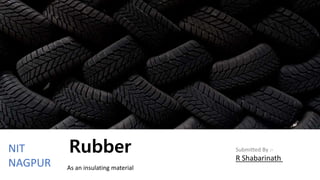Rubber
•Télécharger en tant que PPTX, PDF•
1 j'aime•83 vues
Uses of Rubber in Construction field
Signaler
Partager
Signaler
Partager

Recommandé
Recommandé
Rubber is important for us because it is used at all lifedq6c0qv2jd2mzryt615v84r19l68hgprws31r689gt5shxfwxy8qxzkm790x4Acvfwcsy416gmf0s...

dq6c0qv2jd2mzryt615v84r19l68hgprws31r689gt5shxfwxy8qxzkm790x4Acvfwcsy416gmf0s...ebtesamhamdyabdulgha
Contenu connexe
Tendances
Tendances (20)
Weh61882 61886 high temperature resistance finish coat (200-600℃) (all k...

Weh61882 61886 high temperature resistance finish coat (200-600℃) (all k...
Similaire à Rubber
Rubber is important for us because it is used at all lifedq6c0qv2jd2mzryt615v84r19l68hgprws31r689gt5shxfwxy8qxzkm790x4Acvfwcsy416gmf0s...

dq6c0qv2jd2mzryt615v84r19l68hgprws31r689gt5shxfwxy8qxzkm790x4Acvfwcsy416gmf0s...ebtesamhamdyabdulgha
Similaire à Rubber (20)
dq6c0qv2jd2mzryt615v84r19l68hgprws31r689gt5shxfwxy8qxzkm790x4Acvfwcsy416gmf0s...

dq6c0qv2jd2mzryt615v84r19l68hgprws31r689gt5shxfwxy8qxzkm790x4Acvfwcsy416gmf0s...
Dernier
https://app.box.com/s/7hlvjxjalkrik7fb082xx3jk7xd7liz3TỔNG ÔN TẬP THI VÀO LỚP 10 MÔN TIẾNG ANH NĂM HỌC 2023 - 2024 CÓ ĐÁP ÁN (NGỮ Â...

TỔNG ÔN TẬP THI VÀO LỚP 10 MÔN TIẾNG ANH NĂM HỌC 2023 - 2024 CÓ ĐÁP ÁN (NGỮ Â...Nguyen Thanh Tu Collection
Dernier (20)
Salient Features of India constitution especially power and functions

Salient Features of India constitution especially power and functions
ICT Role in 21st Century Education & its Challenges.pptx

ICT Role in 21st Century Education & its Challenges.pptx
UGC NET Paper 1 Mathematical Reasoning & Aptitude.pdf

UGC NET Paper 1 Mathematical Reasoning & Aptitude.pdf
TỔNG ÔN TẬP THI VÀO LỚP 10 MÔN TIẾNG ANH NĂM HỌC 2023 - 2024 CÓ ĐÁP ÁN (NGỮ Â...

TỔNG ÔN TẬP THI VÀO LỚP 10 MÔN TIẾNG ANH NĂM HỌC 2023 - 2024 CÓ ĐÁP ÁN (NGỮ Â...
Interdisciplinary_Insights_Data_Collection_Methods.pptx

Interdisciplinary_Insights_Data_Collection_Methods.pptx
Python Notes for mca i year students osmania university.docx

Python Notes for mca i year students osmania university.docx
NO1 Top Black Magic Specialist In Lahore Black magic In Pakistan Kala Ilam Ex...

NO1 Top Black Magic Specialist In Lahore Black magic In Pakistan Kala Ilam Ex...
ICT role in 21st century education and it's challenges.

ICT role in 21st century education and it's challenges.
Food safety_Challenges food safety laboratories_.pdf

Food safety_Challenges food safety laboratories_.pdf
Rubber
- 1. Rubber As an insulating material Submitted By :- R Shabarinath NIT NAGPUR
- 2. PROPERTIES High Tensile Strength (10-25 MPa) Hardness inherent due to elastomer structure & can also be modified by vulcanization Specific Gravity – 0.96 Bulk Density - 609Kgs/cu.m PHYSICAL Rubber is water repellent Resistant to alkalies and weak acids. More resistance to oil, solvents, oxygen, ozone, and certain chemicals Loosening of elastomer structure when subjected to heat CHEMICAL
- 3. MARKET FORMS 1. Foam rubber (also known as cellular, sponge, or expanded rubber) refers to rubber that has been manufactured with a foaming agent to create an air-filled matrix structure. Commercial foam rubbers are generally made of natural latex. Latex foam rubber, used in mattresses, is well known for its endurance. Available usually in sheets of thickness 10-50 mm.
- 4. 2.RSS Grade Ribbed Smoked Sheets (RSS) are coagulated rubber sheets processed from fresh field latex sourced from rubber plantations adopting modern processing methods. They're categorized into RSS 1x, RSS 1, RSS 2 etc. Based on quality & colour 3. Crepe Rubber Crepe rubber is coagulated latex that is rolled out in crinkled sheets and commonly used to make soles for shoes and boots but also a raw material for further processed rubber products Available in thin sheets of 1-10 mm 4. Solid Rubber Block Rubber processed into blocks of cubes or cuboids in various dimensions according to the need. 5. Concentrated Latex Natural Latex centrifuged and conentrated to 60% dry rubber content. Usually sold with preservation by Ammonia, in liquid form
- 5. APPLICATION • Rubber has been used as an insulator since 1870. • The tightly bound electrons are not free to be shared by neighbouring atoms. The properties of rubber will also cause the electrons to slow down and eventually prevent them from moving at all. • Mainly used in electrical & thermal insulation Rubber Mats used as insulation mats on walls
- 6. Rubber mat flooring used in gyms etc. Electrical insulation mat Insulation gloves